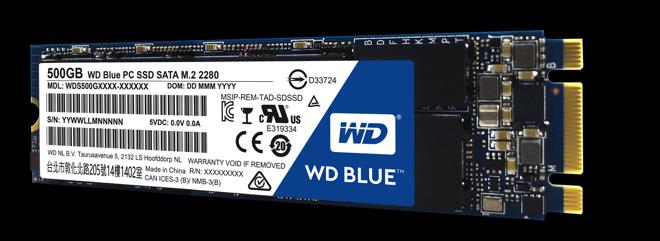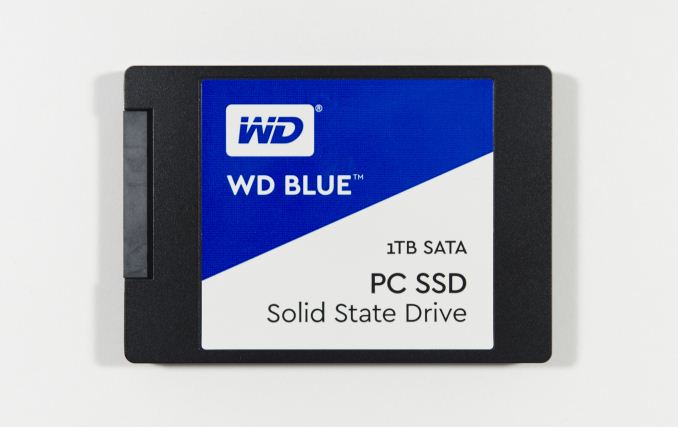Western Digital Introduces WD Blue And WD Green SSDs
by Billy Tallis on October 11, 2016 8:02 AM EST- Posted in
- SSDs
- Storage
- Western Digital
- SanDisk
- TLC

Five months ago, Western Digital completed its acquisition of SSD and NAND flash manufacturer SanDisk, adding consumer SSDs and more enterprise SSDs to their existing portfolio of hard drives and HGST enterprise SSDs. WD is now introducing two families of WD-branded consumer SSDs, each derived from existing SanDisk product lines.
The WD Blue SSD is based on the SanDisk X400 SATA SSD with minimal hardware changes but has modified firmware and different usable capacities. Like the X400, the WD Blue is available as either a 2.5" or M.2 drive and uses SanDisk 15nm TLC NAND with the Marvell 88SS1074 controller. Our review of the 1TB WD Blue SSD shows that it improves on some of the X400's weaknesses but sacrifices some performance on many tests, producing a drive that is not quite as fast overall. The MSRP for the WD Blue is about the same as current actual retail prices for the SanDisk X400, which position it as a mid-range SATA SSD and puts it up against formidable competition from the new wave of drives using the more affordable 3D TLC NAND from Micron.
| Western Digital WD Blue Specifications | |||||
| Capacity | 250GB | 500GB | 1000GB | ||
| Form Factor | 2.5" 7mm SATA or M.2 2280 SATA | ||||
| Controller | Marvell 88SS1074 | ||||
| NAND | SanDisk 15nm TLC | ||||
| Sequential Read | 540 MB/s | 545 MB/s | 545 MB/s | ||
| Sequential Write | 500 MB/s | 525 MB/s | 525 MB/s | ||
| 4KB Random Read | 97k IOPS | 100k IOPS | 100k IOPS | ||
| 4KB Random Write | 79k IOPS | 80k IOPS | 80k IOPS | ||
| Average Power | 70 mW | ||||
| Max Power | 4.4 W | ||||
| Encryption | No | ||||
| Endurance (TBW) | 100 TB | 200 TB | 400 TB | ||
| Warranty | Three years | ||||
| MSRP | $79.99 | $139.99 | $299.99 | ||
The WD Green SSD is an entry-level product line with limited capacity options. Based on the SanDisk SSD Plus, it uses a Silicon Motion controller in a DRAM-less configuration with SanDisk 15nm TLC NAND. The WD Green has a similar purpose to drives like the Samsung 750 EVO and the recently-announced OCZ TL100: to offer the lowest possible price while still providing acceptable reliability and a noticeable performance jump over hard drives. Higher capacities are omitted from the product line because the total price would be too high for the most cost-sensitive consumers even if the price per GB is marginally lower than a more mainstream budget drive.
While the Green label has connotations of better than average power efficiency when applied to WD's hard drives, the low performance of DRAM-less SSDs usually leads to poor energy efficiency during active use and the idle power savings tend to be minimal.
The WD Green will be available later this quarter, and pricing has not been announced.
| Western Digital WD Green Specifications | ||||
| Capacity | 120GB | 240GB | ||
| Form Factor | 2.5" 7mm SATA or M.2 2280 SATA | |||
| Controller | Silicon Motion SM2256S | |||
| NAND | SanDisk 15nm TLC | |||
| Sequential Read | 540 MB/s | 545 MB/s | ||
| Sequential Write | 405 MB/s | 435 MB/s | ||
| 4KB Random Read | 37k IOPS | 37k IOPS | ||
| 4KB Random Write | 63k IOPS | 68k IOPS | ||
| Idle Power | 30 mW | |||
| Encryption | No | |||
| Endurance (TBW) | 40 TB | 80 TB | ||
| Warranty | Three years | |||
Source: Western Digital












13 Comments
View All Comments
Chaitanya - Tuesday, October 11, 2016 - link
Just read the review at Hardwarecanucks, looks like a decent SSD.smorebuds - Tuesday, October 11, 2016 - link
I assume you're saying you just read the Hardwarecanucks review, but this could also read like you're telling people to check out Hardwarecanucks instead. Lol.ikjadoon - Tuesday, October 11, 2016 - link
Dem irregular plurals.Gigaplex - Wednesday, October 12, 2016 - link
Read (red) vs read (reed) are not plurals.masouth - Tuesday, October 18, 2016 - link
I'm guessing that they may have meant irregular verbs.chrysrobyn - Tuesday, October 11, 2016 - link
I always thought WD's Green line traded performance for capacity and that tradeoff happened to be cheaper. We see the IOPS numbers reflecting that decreased performance, but I really wish the capacity was on par. Perhaps this is indicative of SSDs being dominated by a NAND cost that's the same between the two lines. I think there's a market for people who want bigger and bigger SSDs but are willing to trade a lot of performance (but not necessarily reliability) -- if that were possible.goatfajitas - Tuesday, October 11, 2016 - link
WD Green HDD's were always geared for low power and noise, not necessarily any specific storage level. Agreed, higher storage tiers would be good.Valantar - Tuesday, October 11, 2016 - link
Cost-wise, we're not there yet. I doubt that will happen until 3D QLC drives start appearing. (Although these (probably) won't be suitable as system drives due to very limited flash endurance.) Flash is a very, very large portion of the price of an SSD - and larges as capacities grow. While the price delta between a high-end and low-end 120GB SSD might be huge (less than $40 for the cheapest 120GB SATA SSD at newegg, vs. $107 for an 850 Pro, a 167% price increase), that difference diminishes very rapidly (at 256GB, the delta is $60 to $122, or just 103% more). Also, as price competition grows and margins shrink, the only way for SSD makers to profit from drives like these would be volume, and sales of $200+ SSDs are just not large enough for this.Given the inherent links between flash production processes, die capacity, parallelism, and write endurance, you're not going to see high-reliability, low-cost, high-capacity SSDs any time soon. After all, high capacity requires either dense dies (high cost), many packages (high cost), die stacking (high cost) or a mixture of the above. And two out of these three lead to high performance to boot, as long as the controller allows it. High-capacity, low-performance, low-cost, low-reliability? Sure (-ish. they won't be _cheap_ at first), with QLC. Low-capacity, low-cost, low-performance? I'd say we're there already, with decent endurance. But your requested combination is really hard to get to with NAND.
Gigaplex - Wednesday, October 12, 2016 - link
"I think there's a market for people who want bigger and bigger SSDs but are willing to trade a lot of performance (but not necessarily reliability) -- if that were possible."The market for drives that sacrifice a lot of performance for larger capacity is already covered by HDDs.
BrokenCrayons - Tuesday, October 11, 2016 - link
Western Digital may run into some problems when customer expectations conflict with product specifications and performance with their Green series SSDs. They've spent a few years positioning and marketing the Green branding against a certain set of criteria. Now, customers are trained to expect those traits and will likely be tripped up a bit by the different market position of the Green SSDs. It probably would have been better to find a means of categorizing drives that didn't already have a set of perceptions tied to it.